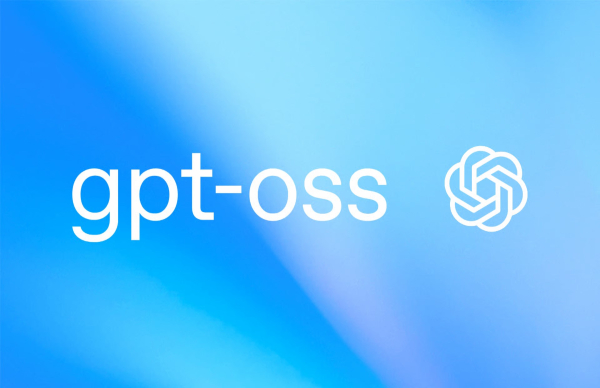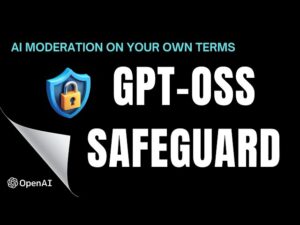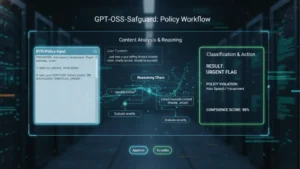OpenAI Releases Research Preview of “gpt-oss-safeguard”
OpenAI has quietly taken another step toward giving developers more direct, auditable control over how content is judged and moderated by releasing a research preview of gpt-oss-safeguard — a pair of open-weight “safety reasoning” models designed specifically to evaluate content against developer-provided policies at inference time. Unlike typical content-filtering models that apply fixed heuristics or binary classifiers, gpt-oss-safeguard is built to read, interpret, and reason about a written policy and then classify user messages, completions, or full chats according to that policy — producing not only labels but also a visible chain-of-thought that explains how the decision was reached. This makes it aimed at teams that want a transparent, customizable Trust & Safety layer they can run locally or in their own cloud environment. OpenAI+1
What exactly is gpt-oss-safeguard?
gpt-oss-safeguard is a family of two fine-tuned models (a large 120B variant and a smaller 20B variant) derived from OpenAI’s gpt-oss base models. The models were purpose-built for safety classification tasks: given a developer-supplied policy (for example, a taxonomy defining harassment, sexual content, self-harm instructions, illicit behavior guidelines, spam categories, etc.), the model will evaluate an input and return structured outputs that indicate whether the content is allowed, disallowed, or needs human review — along with the reasoning steps that led to that conclusion. The project is explicitly positioned as a “bring-your-own-policy” solution, moving away from one-size-fits-all censorship and toward more flexible, organization-specific safety tooling. GitHub+1
Models, sizes, and licensing — who can use this?
OpenAI released two variants in the research preview:
-
gpt-oss-safeguard-120b — the large, high-reasoning model targeted at production use cases that can fit on a single 80GB GPU (e.g., NVIDIA H100 or AMD MI300X). OpenAI describes it as suited for general-purpose, high-reasoning safety tasks.
-
gpt-oss-safeguard-20b — a smaller, lower-latency option for specialized or local deployments that require fewer resources. GitHub+1
Crucially, both models are released under the Apache 2.0 license, making them permissive for commercial use, modification, and redistribution. OpenAI has published the code and usage guidance on GitHub and made model checkpoints available through repositories like Hugging Face for download and local deployment, signaling a continued push toward open-weight tooling after the earlier gpt-oss base releases. This licensing decision lowers friction for organizations that want to vet, adapt, or host safety logic without vendor lock-in. GitHub+1
How does it work — the “bring-your-own-policy” approach
What separates gpt-oss-safeguard from older classifier-based moderation stacks is its design to interpret developer-written policies at inference time. Instead of training a classifier to fit a pre-defined label set, the model ingests the policy text and uses chain-of-thought reasoning to map inputs to the policy’s taxonomy and thresholds. That means:
-
You can change your definitions or thresholds (e.g., what constitutes “violent content” vs. “violent support”) and the same model will apply them immediately without retraining.
-
The model emits a human-readable reasoning trace so moderators and auditors can review the model’s line of thought (this transparency is a double-edged sword — it aids debugging and trust, but also requires careful handling so that internal policy formulation isn’t leaked inadvertently).
-
Organizations can construct granular, domain-specific policy rules and evaluate content consistently against them, enabling use cases like platform moderation, enterprise content filtering, automated pre-triage for human reviewers, and safety QA for generated outputs. OpenAI+1
OpenAI emphasizes this is a research preview intended for teams that want to experiment with and iterate on policy-led safety workflows, rather than a packaged safety product for end users.
Technical safeguards, limitations, and baseline evaluation
OpenAI bundles the gpt-oss-safeguard launch with a detailed technical report and baseline evaluations that aim to quantify how the safeguard models perform across a range of safety tasks. The technical report highlights that these models were evaluated on common safety categories and that the reported metrics represent baseline scores when the safeguard models are used directly for end-user chat — which is not a recommended deployment mode. In other words, OpenAI warns that while the models can classify disallowed requests, they should primarily be used as a moderation/safety layer, not as a conversational model for general chat where user-facing compliance with safety policies is expected. cdn.openai.com+1
The technical documentation also tests the model’s resistance to adversarial inputs (e.g., attempts to circumvent policy), and it shows both strengths and weaknesses: safeguard models are more flexible and explainable, but they can still be tricked by carefully crafted obfuscations or by policies that are vague or self-contradictory. The guidance therefore recommends robust policy authoring (clear definitions, golden-sets for calibration, and continuous human-in-the-loop validation) and thoughtful deployment design, such as using safeguard outputs to route content to human reviewers rather than automatically taking high-impact actions like permanent bans. cdn.openai.com
Practical deployment patterns
OpenAI and community documentation outline several practical patterns for deploying gpt-oss-safeguard:
-
Local inference for privacy-sensitive apps — teams with strict data residency needs can host the models on their infrastructure (particularly the 20B variant for edge or lower-cost inference), giving full control over the data and policies. Hugging Face
-
Policy iteration loop — use gpt-oss-safeguard to auto-label large volumes of content, surface problematic edge cases to human reviewers, refine the policy text and thresholds, then re-run classifications; the model’s chain-of-thought helps explain why items were flagged or missed. cookbook.openai.com
-
Pre-triage for safety teams — operate the safeguard model as a fast pre-filter to prioritize human moderators’ queues; for high-stakes or ambiguous cases, route items to humans with the model’s reasoning included. OpenAI
OpenAI’s recommended practice is to treat these models as components inside broader governance systems — combining automated classification with logging, monitoring, red-teaming, and regular audits.
Why this matters: transparency, customization, and the safety ecosystem
The release of gpt-oss-safeguard points to a maturing ecosystem where organizations want moderators and compliance engineers to have more direct control over how content policies are operationalized. Historically, moderation systems have been either rigid (rule-based systems that miss nuance) or opaque (proprietary classifiers whose decisions were hard to audit). gpt-oss-safeguard attempts to bridge that gap by giving teams a reasoning model that follows the text of the policy and shows its reasoning — making it easier to align automated judgments with the organization’s values and legal obligations.
For researchers and platform operators, the open-weight nature of the models is important because it enables independent evaluation and adaptation. Security researchers can probe the models for failure modes, civil society groups can inspect the behavior for bias, and enterprises can integrate them into compliance workflows without being locked into an external vendor’s definition of “safe.” That said, the release also raises governance questions around how policies are written, who audits them, and how the chain-of-thought artifacts are stored or shared. GitHub+1
Risks and open questions
No release of safety tooling eliminates risk automatically. A few immediate concerns and unanswered questions include:
-
Policy quality dependency: A reasoning model follows the text it is given; poorly specified or ambiguous policies will produce unreliable classifications. Organizations must invest in policy engineering and golden test sets. cdn.openai.com
-
Adversarial attacks: Because the models operate by interpreting policy text, attackers may attempt to craft inputs that exploit interpretable patterns in policy wording. OpenAI’s evaluations show some robustness but recommend human-in-the-loop workflows for high-impact decisioning. cdn.openai.com
-
Privacy and logging: The model’s chain-of-thought can be an invaluable debugging tool but could inadvertently capture sensitive or proprietary policy details if logs are not managed carefully. Teams will need clear logging and redaction policies. OpenAI
-
Operational cost and latency: The 120B variant demands sizable GPU resources (single 80GB GPU class), which can be costly at scale; the 20B variant mitigates this for many scenarios but with trade-offs in reasoning capacity. GitHub+1
How researchers and the community can engage
OpenAI published the code, model cards, and a detailed technical report to encourage community participation. For researchers, typical next steps include:
-
Running independent audits and red-team evaluations to quantify failure modes, biases, and adversarial vulnerabilities. cdn.openai.com
-
Experimenting with policy authoring techniques and golden sets to understand how wording and structure impact classification outcomes. cookbook.openai.com
-
Building tooling around policy management (versioning, testing harnesses, dashboards) so that policy changes can be rolled out safely and traceably. GitHub
Open-source availability accelerates these activities because external teams can run the exact same checkpoints, share reproductions, and contribute improvements via GitHub.
Example use cases (concrete scenarios)
-
Social platforms can use gpt-oss-safeguard to align moderation with local laws and platform-specific norms by supplying jurisdictional policies and letting the model triage content accordingly; the chain-of-thought helps moderators understand ambiguous rulings. OpenAI
-
Enterprise compliance teams can run incoming customer communications through a safeguard pipeline that enforces corporate policy on acceptability and data leakage, flagging items that require escalation. cookbook.openai.com
-
AI product developers can instrument the safeguard model as a safety-check for generated outputs (e.g., content that an assistant would produce) and either block or route risky outputs to a human review flow. cdn.openai.com
These examples show how a policy-as-code approach could be operationalized in practice.
Final thoughts — a meaningful but careful step
gpt-oss-safeguard is not a silver bullet, but it is a meaningful addition to the Trust & Safety toolkit: an auditable, customizable safety reasoning model available under a permissive license. By enabling organizations to bring their own policies and receive explainable reasoning for classifications, OpenAI has lowered a key friction point in building nuanced moderation systems. The research preview and accompanying technical report are also an invitation to the broader community to stress-test the approach, improve policy-engineering practices, and build operational tooling around transparent, policy-led safety. OpenAI+1
If you’re a developer or researcher interested in trying gpt-oss-safeguard: OpenAI has published the repository, usage guides, and model checkpoints (e.g., via Hugging Face), plus a technical report describing baseline evaluations and recommended practices — a useful place to start experimenting and building your own policy-driven safety workflows. GitHub+2Hugging Face+2
For quick updates, follow our whatsapp –https://whatsapp.com/channel/0029VbAabEC11ulGy0ZwRi3j
https://bitsofall.com/https-yourblogdomain-com-microsoft-releases-agent-lightning/
MiniMax Releases MiniMax M2 — a fast, cheap, agent-ready open model






